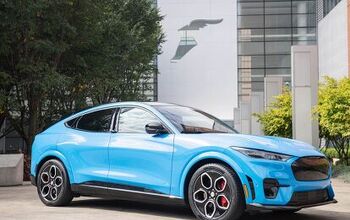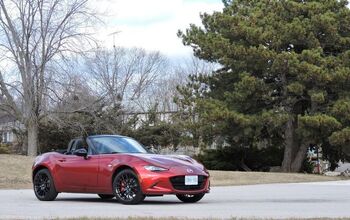An Homage to the Dodge Viper: Taking My Car Back to Its Birthplace

This year marks a bittersweet occasion for Dodge and a dedicated team of craftsmen, engine builders, and assembly experts at the Conner Avenue assembly plant, which has built the Dodge Viper for years.
This year is the 25th anniversary and seemingly permanent retirement of one of America’s most radical sports cars. The Viper has benefited from a tremendous following, a loyal owner’s community, and a colorful career in motorsports.
Since its 1992 launch as the Viper RT/10, Dodge and SRT (Street and Racing Technology, the name of Dodge’s high-performance brand) have sold about 30,000 units, all of which were proudly built in Detroit and most of which rolled out of Conner Avenue Assembly.
I recently traveled there for a very special road trip because I own a Viper and it just seemed like the right time.
Detroit’s 8th Mile Road and Conner Avenue have been home to Conner Avenue Assembly for more than 20 years. Originally a spark plug factory, Chrysler bought it from Champion in the 1990s and turned it into a specialized assembly plant. At 392,000 square feet, it’s a big building. But it’s more of a workshop than an actual factory and a fraction of the size of a mass-production facility that builds higher volume machines.
ALSO SEE: Dodge Viper Assembly Plant to Close Indefinitely
Conner Avenue Assembly is about a nine-hour drive from my current home in Sudbury, Ontario, but only about 20 minutes and a border crossing from the neighborhood in Windsor, Ontario, where I was born. This is where I spent my early years and first fell in love with cars.
I grew up near Conner Avenue. In those early years, I’d make my dad chase down any Dodge Viper I spotted with the family minivan so I could have a closer look. I’d chase Vipers on my bicycle, too, hoping for a listen. By my mid-teens, I had amassed a case of magazines, posters, books, and any literature I could get my hands on about the big beast from Michigan.
And so now, some years later on a cold and sopping wet November morning, I was pushing my luck with the weather and temperatures (along with some leaky doors and windows) in my own Dodge Viper, a 2000 GTS. I was bringing my dream car “Bubbles” home to meet some of the people that built her. Painted her. Bolted her engine together. Started her up for the first time. Installed her dashboard and seats. These folks also attached the often-problematic doors that sag and leak with age, adding to the primitive charm of Viper ownership.
After a treacherous drive through the cold morning with apocalyptically heavy rain (and many concerned looks from the locals), I arrived at a security gate, just at the edge of a short driveway that led to the facility’s main doors. Pull up in front, get out, and head in. It’s no more complicated than going inside a Home Depot. And, despite building one of the most extreme and startling performance cars around, Conner Avenue Assembly is a bizarrely civilized place.
As the former owner of the original 2000 Viper GTS Coupe (Bubbles) I took on this road trip, and the current owner of a 2008 Viper SRT10 Coupe (Snuggles) that replaced her a few months back, I love, live with, and take pride in the pure, mechanical, no-BS, and primitive feeling of this machine on the daily. The footwells overheat on long drives. The exhaust drone is thick through the cabin. The steam-roller tires grab every imperfection in the road and make the car squirm beneath you, almost constantly. A Viper is an exhausting machine to drive at times, but this makes it a special car.
I was hoping my visit to the assembly plant would validate this. I wanted to see a factory full of smoke, sparks, greasy floors, shouting workers, metal clanging, and hopefully, a guy using a sledgehammer while having a cigarette. When you drive a Dodge Viper, you’re pretty sure that somewhere in the assembly process, a guy using a sledgehammer and having a cigarette is involved.
No dice.
It’s airy, comfortable and bright inside. Quiet, too. Heck, there isn’t even a hum from the bright overhead lamps. The temperature is perfect. Big ventilation fans create a pleasant breeze. It’s clean and organized and if you dropped your sandwich on the floor, you wouldn’t think twice about picking it up and finishing it.
There are no welding sparks, as Viper’s hand-welded frame structures are built off site, then shipped in. No grease. No smoke. No heat. No noise. That all happens elsewhere. Here, at Conner Avenue, components are collected, assembled, combined and turned into Vipers.
Dozens of workstations surround a central parts store. In the same way a chef visits his fridge with a recipe and a cart to gather ingredients for the day’s special, Viper builders visit the parts store with giant racks and their work orders, gathering the ingredients for the day’s builds.
I witness one builder, Heidi Lafleure, yank a large, magnesium “front of dash” structures from a rack, installing them to a machine that locks them stationary and sets off fastening the appropriate pedal-sled, brake booster and other hardware. Her smart torque wrench auto-tightens bolts to the appropriate level as she installs the components, tracking each bolt and cross-referencing everything on a computer display. When done and triple-checked, Lafleure sends her assembled dash structure over to another builder, Darrel Dodds, who installs and routes numerous wiring harnesses throughout the assembly.
The Viper’s V10 engine blocks come from a supplier and are built up on site. Sensors are attached first, then wiring, pistons, rods, pushrods, the camshaft, rockers, covers, spark plugs, manifolds, belts and all the rest.
One builder, Angella Richberg seems to be an avid photographer who was as curious about my wide-angle lens as I was about her part in building Viper engines. She smiles, working away under bright lights, adding lubrication and dropping the pushrods into their shafts. She walks around the engine, inspecting it with a sharp eye. I’m delighted to see my first Dodge Viper engine that’s not in a car. It looks much smaller when it isn’t filling the front half of a two-seat body.
Richberg’s co-worker is Greg Rinehart. These two are clearly friends, chatting all day, and even playing cards together at lunch. Rinehart hooks up larger external parts to the engine, including the timing cover and water pump provisions, before an initial engine test commences.
ALSO SEE: One Texas Couple Owns 79 Dodge Viper Sports Cars
“The engine block in your car, and the pistons, are similar” Rinehart tells me, hooking up a wiring harness to the oil pressure and coolant temperature sensors. “The manifolds are different, and the new engine has some lighter parts. It’s more powerful now, but the engines are really pretty similar in many ways”.
“Would you have built my engine?” I ask. For model-year 2000, staff at Conner Avenue built about 950 copies of the Viper GTS, of which less than 10 percent were shipped to Canada, like mine.
“Oh, almost definitely!” he replied with a proud smile.
Rinehart wheels the completed engine over to a frightening machine covered in cables and wires and plugs, like something out of a horror movie. It’s said to be extremely picky. The so-called cold-test machine checks for proper plug gaps, any signs of gasket leaks, the connectivity of the computer system and all sensors. It runs nearly 900 tests before the engine is put into the car.
Engines are installed into partially completed Vipers, which wind up at Thomas Ballard’s station. Ballard’s job is a special one: he brings new Vipers to life by pumping in fluids, fuel, charging the air conditioner, installing tires and finally initializing the computer system. At Ballard’s station, the new Viper is activated, becoming a functional car even if much of the cabin and all of the bodywork are still missing.
As a result, the Viper looks like a sinister go-kart. It has no doors, no windows, and no body panels. Ballard carries a special seat into the incomplete body and drives the car onto a dynamometer roller before securing it, hooking up numerous sensors and accelerating hard, several times, with his eyes glued to a large, overhead computer readout. He’s stone-faced; watching intently as data feeds stream across the screen. Sensors, power output, fluids and other parameters are checked, as the Viper’s engine is given its first hard workout, just moments after firing up for the first time. Only once Ballard approves of what he sees, is the vehicle ready for final assembly.
Jill Braunschneider gets the vehicle next. She applies fasteners and bracing to the rolling chassis to prep it for body panel installation. She wheels around the Viper in a special chair, installing special clips that help secure panels to the frame beneath.
“You should get one of these,” she says. “It’s the ACR Extreme.”
Braunschneider is smiling intensely, her sense of pride is gushing. These folks are normal folks, with kids, families, partners, and goals. But they build really freaking awesome cars and they know it.
“Look at those adjustable dampers,” she continues bragging. “And the brakes, too. This thing is serious. You should get one. It’ll be a nice upgrade from your 2000,” she adds, still beaming. Braunschneider works fast and intensely, with a big grin, as she preps Vipers for the installation of their body panels.
ALSO SEE: Top 5 Reasons the Dodge Viper Should Live On
Doors go on next, with bumpers and other body panels roughed in place. Then, Jeremy Gonzalez and Anthony “Smooth” Thomas fasten bumpers, the hood and the doors and other panels to the Viper’s structure. In applying the pre-manufactured body panels, which are built and painted off-site by a company called Prefix, Gonzalez and Thomas make the Viper start looking like one.
With the bodies applied, the Vipers move to a special inspection area. Here, staff from Prefix work with staff from Conner Avenue, under special flaw-revealing lighting to look for trouble. Specialists Bonnie Marth and Krystal Kozak go inch-by-inch over a completed Viper ACR, touching every panel and seam, moving their heads and squinting to see each part of the paintwork from various angles.
“There’s some orange peel, here,” Kozak tells Steven Showalter, pointing at the rear edge of an ACR’s park-bench-sized spoiler. Showalter inspects it and returns a moment later with a buffing wheel and compounds. He works a moment to correct the issue and then completes the polish by hand. Another car arrived moments later, with a tiny defect in the hood emblem circled in wax crayon.
Staff scrutinize each other’s work, playfully, but with a serious tone. The various stages of buffing, polishing, and re-inspection ensure all units are consistently perfect from a visual standpoint before they enter a climate-controlled room. This is where the completed vehicles are stored until they’re transported to owners.
“That’s a lot of smiles, ” I thought to myself, standing in the doorway of the pre-delivery room. This was a privilege. I wasn’t allowed past the doorway, but here sat several million dollars worth of hand-built American supercar and I got to see a few dozen Vipers custom-designed by their owners before those owners did.
ALSO SEE: 10 Cars the Dodge Viper Beats at the Nurburgring
Owners are allowed and encouraged to visit the factory for pickup, too.
A purple ACR sat near the factory foyer, just across from a bunch of retired Viper racecars proudly displayed, filthy and covered in grass, brake dust and dirt. The retired race cars all look as though they just got finished kicking some ass.
And the new purple Dodge Viper ACR, gloriously displayed across from its retired siblings and brand spanking new, was a customer pickup. The folks at Conner Avenue want customers to come see them. They want to show off the smiles, the pride, and the expertise that go into each and every car.
“This owner is coming to pick his car up here, in a week or so,” Jim Richards, my tour guide tells me. “Some come to see their car here and then we ship it to them. Others come here, meet the people who built it and drive it away. It’s almost like a family”.
It’s a family I’m proud to be some part of.

Justin Pritchard, an award-winning automotive journalist based in Sudbury, Ontario, is known for his comprehensive automotive reviews and discoveries. As a presenter, photographer, videographer, and technical writer, Justin shares his insights weekly through various Canadian television programs, print, and online publications. In 2023, Justin celebrated a significant milestone, airing the 600th episode of his TV program, AutoPilot. Currently, he contributes to autoTRADER.ca, Sharp Magazine, and MoneySense Magazine. His work as a technical writer, videographer, presenter, and producer has been recognized with numerous awards, including the 2019 AJAC Video Journalism Award and the 2018 AJAC Journalist of the Year. Justin holds a Bachelor of Commerce (Hons) from Laurentian University, which he earned in 2005. His career in automotive journalism began that same year at Auto123.com. Since then, he has written one of the largest collections of used car buyer guides on the internet. His passion for photography, nurtured from a young age, is evident in his work, capturing the scenic beauty of Northern Ontario. Living in a region with a particularly harsh winter climate has made Justin an expert on winter driving, winter tires, and extreme-weather safety. Justin’s significant achievements include: 2019 AJAC Video Journalism Award (Winner) 2019 AJAC Road Safety Journalism Award (Runner-Up) 2019 AJAC Automotive Writing (vehicle review topics) (Winner) 2019 AJAC Automotive Writing (technical topics) (Winner) 2018 AJAC Journalist of the Year You can follow Justin’s work on Instagram @mr2pritch and YouTube @JustinPritchard.
More by Justin Pritchard















































































































Comments
Join the conversation
The best piece of journalism I have read on this site. I felt the passion through the article and it showed why all us enthusiast have such passion for cars. Keep it up!
Nice read. I got to tour the Conner Ave. plant a few years ago, 2011 I think, and it was amazing. That huge room of completed cars... :)